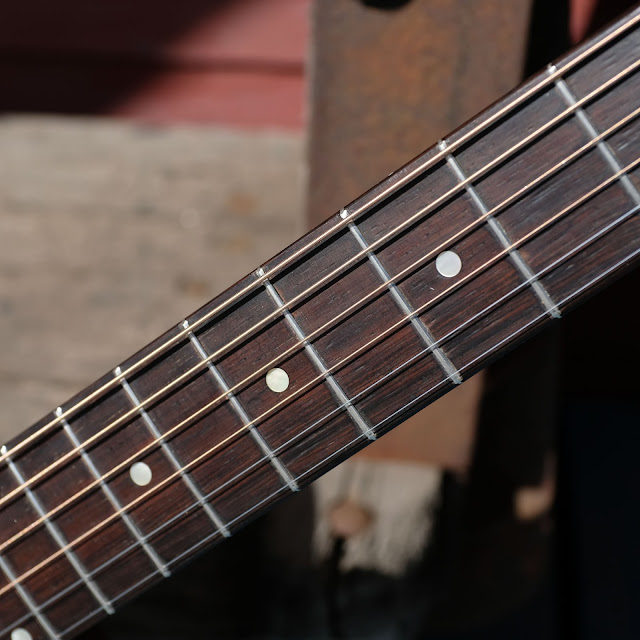1933 Gibson-made Kalamazoo KG-11 Flattop Guitar
A customer of mine traded this to me for a guit-box in my own collection, so I quickly set to work ironing-out the setup issues on this afterwards. The factory order number at the neckblock is obscured by old repair work and faded anyway, but I'm certain that this is a '33 or, at latest, an early '34. It has a small-sunburst finish that would've been black-to-orange-brown to begin with, but has faded wider and the whole thing has turned a dark, walnut-brown where it would've been black before.
Obviously, it's also been played a ton which is why the voice of the guitar is as sweet and warm as it is. The average Kalamazoo is pretty up-front and zippy when driven, but this one has just a bit more mwah. Your playing style will decide which suits you better!
There are a ton of old repairs to the guitar, including a neck reset and heel-crack (very minor one, at the foot) repair, crack repairs and cleats to the back and top, crack repairs to the sides, a shot of overspray just on the back, and it'd previously seen some wonky fret leveling and a light shave to the bridge's front edge.
My own repairs included a fret level/dress, modification of the saddle slot to a drop-in saddle configuration and some cleaning-up of the bridge, side dots, general cleaning, a new bone saddle, side dots, and a good setup with 50w-11 strings. The neck essentially straight via the fret level/dress and at tension only deflects ~1/64" -- very good, too, considering that the neck shape on this is a little rounder and slimmer than the average KG-11. It feels approximately like a period Gibson truss-rodded neck, instead.
Specs are: 24 3/4" scale, 1 11/16" nut width (yep -- they're usually 1 3/4"), 1 1/2" string spacing at the nut, 2 3/8" spacing at the bridge, 14 3/4" lower bout, 10" upper bout, and 4" depth at the endblock. Action is 3/32" EA and 1/16" DGBE at the 12th fret.
In case you missed previous blog memos about KG-11s, these guitars are ladder-braced, have solid spruce tops, solid mahogany back, sides, and necks, and rosewood fretboards and bridges.
The original ebony nut is still going strong.
The frets are the typical, low, smallish Gibson stuff.
I love that pickwear!
Originally, this bridge would've been sprayed-over with finish. Said finish was half-removed when it came in and it still had its original saddle slot, though it'd been mucked-with a bit. I filled the outside edges of the slot to make the slot drop-in for easier setup changes, cleaned-up some of the bridge muck, added light string-ramping behind the saddle, and cleaned-up the look somewhat.
As you can see, there's plenty of saddle height for action-height adjustments down the road.
The mahogany back is one piece and there are a couple of repaired hairline cracks in it.
The original tuners are a little fussy (as usual for this type), but do hold pitch once you get them dialed-in. I have a few sets of StewMac repro tuners on hand if the next owner wants to upgrade.
The very bottom of the heel has a tiny repaired hairline crack in it. The dovetail doesn't even go down that far, so it's a non-issue.
Here's a cluster of cracks on the side that was glued-up in the past.
On the other side, there's also this hairline crack that was glued-up before me.
An oversize, vintage, hard, classical guitar-style case comes with it.





















Comments